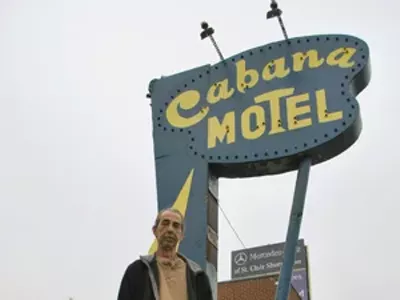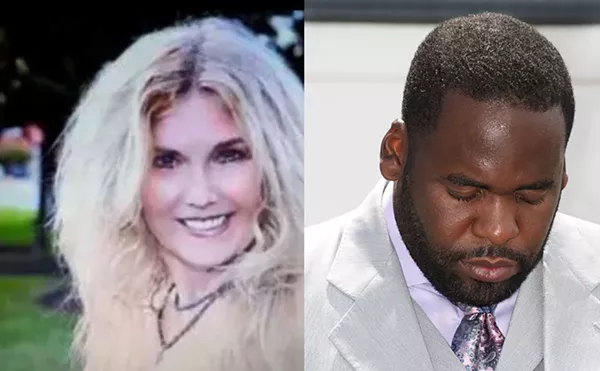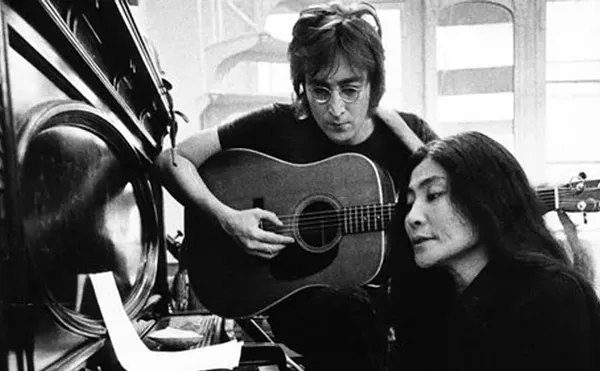
Audio By Carbonatix
[
{
"name": "GPT - Leaderboard - Inline - Content",
"component": "35519556",
"insertPoint": "5th",
"startingPoint": "3",
"requiredCountToDisplay": "3",
"maxInsertions": 100,
"adList": [
{
"adPreset": "LeaderboardInline"
}
]
}
]
Called Out of Darkness: A Spiritual Confession
by Anne Rice
Alfred A. Knopf, $24, 245 pp.
Ann Rice has undergone a spiritual and literary conversion. It has polarized her life and writing in a way that makes you wonder if a Christian can write about vampires or if an atheist can write about God.
After a hugely successful string of goth and historical novels, which began with 1976's career-defining Interview with the Vampire, Rice abandoned atheism and returned to Catholicism. She chose Jesus over vampires, a transition marked by the 2005 novel Christ the Lord: Out of Egypt. Christ the Lord: The Road to Cana followed this year.
Always a decadent, passionate observer of life's rich color and decor, Rice wrote about Christ with the same appetite for beauty that drove her vampire books and the three pseudonymously penned (A. N. Roquelaure) erotic novels.
Called Out of Darkness is Rice's spiritual memoir, a chaste yet — not surprisingly — hungry account of her formative years in New Orleans, where she was constantly dazzled by the symbols and buildings that represented her religious faith.
She writes about Catholic Mass with the breathy reverence of a woman decorating an altar with flowers. Her story moves chronologically through her radical years in Berkeley, Calif., where she connected with artists and "secular" people who influenced her creative life. She remembers them with a guarded appreciation and writes about them across a divide between the believer and nonbeliever, as if too much fondness might contaminate her return to God.
The trauma and loss in her life are as relevant to her conversion as her intense study of the Gospels. She lost a 5-year-old daughter to leukemia and later her beloved husband, Stan. (And haven't pain and mortality sent many searching for something to believe in?)
In short, Rice is done with vampires and really into God, but she observes the subjects with the same obsessive visceral sense. Whether she's describing a monster's bloodlust or daydreaming about her own hand touching the hem of Christ's robe, it's all palpable longing and blossoming wonder — a state of mind where the world remains a strange seductive place in both darkness and light. —Norene Cashen
Downtown Owl
by Chuck Klosterman
Scribner, $24, 288 pp.
Downtown Owl is about people living dinky little lives in a dinky little town in the middle of nowhere, but the novel's ambitions are quite a bit loftier than the humble dreams of its central characters. With his fiction debut, this columnist, lit darling and best-selling essayist (Sex, Drugs and Coca Puffs) crafted a kind of tribute to lonely people; the struggling ham-and-eggers who grind away in obscurity but are no less worthy of compassion than those closer to the spotlight — a place that the author certainly isn't afraid of.
Klosterman is a sort of new millennial Lester Bangs; he's a hyper-literate, wonky wise ass — the New York Times bestseller is the most popular writer in America for those under 30 — who exalts the pleasures of low culture, an unembarrassed cheerleader of such unsavory treats as McNuggets and hair metal. His discount brand of populism runs parallel with a snotty contrarian streak that makes him the hero of journalism undergrads and the nemesis of certain highbrow cultural critics who turn their nose up at such deliberate glibness.
Set in the fall of 1983, the novel follows three protagonists: Horace, a crotchety widower; Julia, a young teacher newly moved to town; and Mitch, a third-string sophomore quarterback who can't understand his friend's obsession with ZZ Top and other such bands.
At times you'd think Klosterman's wrenching references from Trivial Pursuit's '80s edition, but while the townsfolk watch Dallas and Magnum P.I, the area's real pop culture is all about minding the others' business. It's a place where everybody knows your name, your nickname and the embarrassing personal details of your bio. Yet despite the common knowledge, the citizens of Owl, N.D., are ultimately alone, left to fend for themselves; a point hammered home too bluntly by a disaster and feels a bit too cruel and hasty. Still it's an exciting debut crammed with small-town truths, and like it or not, Klosterman has a bright future ... in the spotlight. —Corey Hall
My Life in Porn: The Bobby Blake Story
by Bobby Blake
Running Press, $14.95, 296 pp.
Who knew porn actors could read, let alone write a memoir? Well "write" is a debatable term, but certainly the story of Bobby Blake, former exotic dancer turned escort turned gay porn icon turned born-again preacher was worth dictating to someone. In fact, the book kicks off with a Bible quote — the first surprise in what turns out to be a real (guilty?) pleasure, a read that's both oddly intriguing and gloriously stupid.
Blake was a dominant African-American stud in the mid-'90s gay scene, a fact he's never shy about, though he swears to be mostly bisexual, and is now a "reformed" minister and youth advocate. Blake spins his seedy bio with great candor and zero self-awareness, unashamedly chatting about his time turning tricks, race politics and shockingly boasting about "dogging out" fellow performers he thought were "weak," with humiliating displays of sexual prowess. This is a guy who treats his "style of fucking" like it was a sacred science he was sent to earth to practice. It's a confounding cocktail of macho posturing, deep shame and proud declarations of love for co-star/ex-lover "Flex Deon." (All this queerspeak sidles up to confused anti-gay marriage screeds.) None of this is recommended for the faint of heart — it's loaded with graphic detail, dirty deeds and an even more obscene display of runaway ego. —Corey Hall
Good-Bye
by Yoshihiro Tatsumi, edited by Adrian Tomine
Drawn & Quarterly, $19.95, 208 pp., hardcover
Life isn't always fair. So often, we get more — or far, far less — than we bargained for en route to that inevitable dying of the light. The doomed, damned characters who populate the world of Japanese cartoonist Yoshihiro Tatsumi could certainly attest to this cruel reality. In Good-Bye, a visual-art short-story collection drawn in 1971 and 1972, we literally bear witness to soul-crushing revelations, bitter betrayals and a far-out, symbolic mysticism that feels almost plausible. Working in black-and-white, the artist-author juxtaposes a caricaturist's goofy eye for figures and pedestrian, workmanlike dialogue with backdrops that are often startlingly detailed; the effect simultaneously conveys that these dark tales could really occur and heightens their comic-book surrealism. Whether the setting is a public shrine, a smoldering urban landscape, a bar at closing time, a dilapidated apartment building or a remote forest clearing, there's a gritty, poetic solemnity to Tatsumi's backgrounds; it almost seems as if one could reach through the page and touch them.
The despair comes in tsunami waves. "Hell" finds an unnamed military photographer on the horns of a dilemma. Wandering through the nuked ruins of Hiroshima in 1945, he shot a picture of two connected shadows, blasted into a wall at detonation; the etching appears to be of a son massaging his mother's shoulders. The snapshot earns our protagonist great wealth and prestige; a statue of his subjects is erected, and their identities are revealed. To say either that the shutterbug — and an enraptured, post-World War II Japan — misread the photo or that the outcome of this story is morally horrific would be a gross understatement. "Just a Man" catalogues a retired salaryman's utter lack of potency. After a life of walking the straight and narrow — dutifully providing for a family that doesn't respect him — the homely Mr. Hanayama is inspired by a cannon on display in Yasukuni Shrine, a memorial to those who died fighting for the emperor. He decides to take some risks: He's going to use his pension money to gamble on races and visit a prostitute, thereby cheating on the unfaithful wife he despises. Yet he can't bring himself to sleep with a stranger he doesn't love, and when he finally crawls into bed with a comely secretary from his workplace, he just can't get it up.
In the Kafka-esque "Sky Burial," a young man's increasing detachment from his schoolwork, his girlfriend and his best buddy correlates with the growing flock of low-flying buzzards that trail him wherever he goes. Elsewhere, a hard-hearted hooker services American GIs, futilely hoping one of them will spirit her away from a life of squalor — only to have her alcoholic father drink away her earnings. The desperate miniatures of Good-Bye represent something much more than alt-comix doodles — these are top-shelf mid-20th century literature. —Raymond Cummings
Bottlemania: How Water Went on Sale and Why We Bought It
by Elizabeth Royte
Bloomsbury, $24.99, 248 pp., hardcover
As recently as 10 years ago, the mere act of toting or hoisting a bottled water carried a strong whiff of snobbery, like driving a BMW or a Lexus. Today, sipping Dasani, Perrier or Deer Park in public barely raises an eyebrow; it's just another beverage choice, like soda or juice — nothing especially offensive or ostentatious. In Bottlemania: How Water Went on Sale and Why We Bought It, author Elizabeth Royte exhaustively explores what drinking bottled water actually means, details the local effects of pumping millions of gallons of H20 from underground aquifers, and offers pros and cons.
Bottled water is big, big business — Americans spent $10.8 billion on the stuff in 2006 — so the stakes for bottlers are high, sabotage of pump houses by militant environmentalists could easily derail profits, and security is drum-tight. As the purity of tap waters are called into question, and the cultural fabric frays into hyper-individualism, we've increasingly turned to the Poland Springs of the world. In turn, bottlers thrive and multiply, their coffers swell, and they offer economically stricken communities relative pittances in exchange for exclusive pumping rights. Then, as water levels drop, wildlife is adversely affected, private wells go dry and, suddenly, people start to worry about whether there's enough potable water to go around. The likes of NEWater — a Japanese bottled brand that's essentially heavily treated wastewater — are scoffed at, though they may be harbingers of things to come.
The myriad ironies on parade here would be delicious if they weren't so damned scary: A natural resource that's supposed to be free has been transformed into a hot commodity; selling more and more supposedly purified water in plastic bottles results in more pollution that ultimately requires heightened filtering on the part of bottlers and municipal water authorities alike; the more that people avoid drinking tap water and cede power to bottlers, the less inclined politicians are to put tax money into updating and maintaining existing city and suburban water systems. Case in point: "The city of Baltimore, after 15 years of trying to remove lead from public schools' water fountains, in 2007 gave up and switched to coolers of bottled water," Royte notes. We've met the enemy, and they are us — we're drinking ourselves into disaster. —Raymond Cummings
State by State: A Panoramic Portrait of America
Edited by Matt Weiland and Sean Wilsey
Ecco Press, 608 pp.; $29.95
State by State re-creates, in condensed form, the American Guide series, a collection of 48 books published between 1938 and 1941 as part of the Federal Writers Project. Some of the greatest writers of the era — Saul Bellow in Illinois, Zora Neale Hurston in Florida and Eudora Welty, who took photographs in Mississippi — contributed to those classic guide books, which contained maps, essays on history and culture, automobile tour guides, and portfolios of photographs. In recent years, scholarly work at the Library of Congress has unearthed evidence of just how many literary luminaries participated as editors, writers, interviewers and photographers in this New Deal effort. State by State editors Matt Weiland and Sean Wilsey, who are on the staffs of The Paris Review and McSweeney's, respectively, have likewise gathered a star-studded list of state chroniclers. Practicality, however, is set aside; whereas the earlier books were published by each state and intended for tourists' use, State By State is a decidedly personal literary endeavor.
Much of the writing is affecting: Novelist Benjamin Kunkel's evocation of his parents' participation in the back-to-the-land movement, and of the land itself in Colorado, is superb, as is short-story writer Jhumpa Lahiri's tale of her immigrant parents' experiences in Kingston, R.I. While Kunkel, Lahiri and many of their fellow contributors mine personal experience for their contributions, others elucidate little-known aspects of a state's history, as does Anthony Doerr in describing the travails — inhospitable conditions, disease, an 1879 battle with the U.S. Army — of the Tukudeka tribe in Idaho.
Platitudes inevitably creep in. Residents of both Maine and Michigan, as described by Heidi Julavits and Mohammed Naseehu Ali, espouse a gruff, independent-minded live-and-let-live philosophy, and Ali's Michigan has rabid sports fanatics in common with John Hodgman's Bay Staters. But inspired choices — chef Anthony Bourdain on New Jersey, musician Carrie Brownstein on Washington, filmmaker Alexander Payne on Nebraska — make up for the smattering of clichés and the occasional dud entry, among them William T. Vollman's largely sour assessment of contemporary California ("Who believes in the 'California dream' anymore?" he asks) and Jonathan Franzen's supremely ill-conceived imaginary interview with the state of New York and "her" handlers. While the strong emphasis on folkways, landscape and history so present in the earlier series is largely missing from this volume, at its best it elicits a desire to return to the original books and to learn more about our unwieldy, dynamic, variegated land and its people. —Brian Sholis





